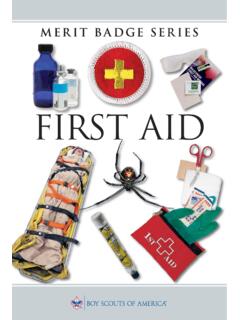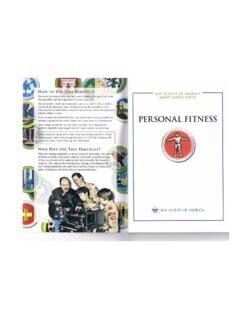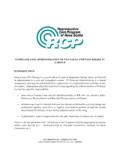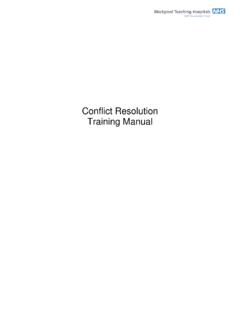Transcription of campinG - Troop 109
1 campinG How to Use This Pamphlet The secret to successfully earning a merit badge is for you to use both the pamphlet and the suggestions of your counselor. Your counselor can be as important to you as a coach is to an athlete. Use all of the resources your counselor can make available to you. This may be the best chance you will have to learn about this particular subject. Make it count. If you or your counselor feels that any information in this pamphlet is incorrect, please let us know. Please state your source of information. Merit badge pamphlets are reprinted annually and requirements updated regularly. Your suggestions for improvement are welcome. Send comments along with a brief statement about yourself to Youth Development, S209 Boy Scouts of America 1325 West Walnut Hill Lane Box 152079 Irving, TX 75015-2079.
2 Who Pays for This Pamphlet? This merit badge pamphlet is one in a series of more than 100 covering all kinds of hobby and career subjects. It is made available for you to buy as a service of the national and local councils, Boy Scouts of America. The costs of the development, writing, and editing of the merit badge pamphlets are paid for by the Boy Scouts of America in order to bring you the best book at a reasonable price. BOY SCOUTS OF AMERICA. MERIT BADGE SERIES. campinG . Note to the Counselor The campinG merit badge challenges Scouts mentally and physically. campinG helps the Boy Scouts of America deliver the promise of outdoor adventure to Boy Scouts. At all times that Scouts participate in a BSA activity, they must have the proper supervision.
3 By following the guidelines under III. campinG in the BSA's Guide to Safe Scouting, unit leaders can help ensure the well-being of Boy Scouts under their supervi- sion. Those guidelines are discussed here briefly. Wilderness campinG . Have a plan to help minimize risks and manage a crisis should one occur. Involve Scouts and Scouters in this process so that they all know of and know how to avoid potential dangers. campinG takes proper planning, leadership, and good judgment. Trail safety. Stay alert; take care in everything that is done on the trail, and plan activities within the group's ability and maturity level. Alert youth members to the dangers of unusual environment with proper instruction on fire safety, orienteering, and safe travel.
4 On the trail, instruct group members to stay together, and avoid loose rocks and dangerous ledges, cliffs, and areas where a fall might occur. When Scouts understand the reason for rules of safety, they more willingly abide by those rules. It is strongly recommended that at least one person in the group be currently trained in first aid through the American Red Cross or any recognized agency. Trek Safely. Fun and safe overnight trekking activities require compliance with Trek Safely by both adult and youth leaders. 1. Qualified supervision. All backcountry treks must be supervised by a mature, conscientious adult at least 21 years 35866. ISBN 978-0-8395-3256-9. 2005 Boy Scouts of America 2010 Printing BANG/Brainerd, MN. 3-2010/059111.
5 Of age who understands the potential risks associated with the trek. This person knowingly accepts responsibility for the well-being and safety of the youth in his or her care. 2. Keep fit. Require evidence of fitness from youth and adults by having each participant fill out a current BSA Personal Health and Medical Record Class III form. No one should participate in a trek or activity for which he or she is not physically prepared. 3. Plan ahead. For travel of more than 500 miles, submit the National Tour Permit Application to the local council service center at least a month before the departure date. For activi- ties off the local council property and within 500 miles of home base, submit the Local Tour Permit Application. Units should anticipate a range of weather conditions and tem- peratures and develop an alternate itinerary.
6 4. Gear up. Procure topographic maps, as well as current trail maps, for the area of the trek. Take equipment and clothing that is appropriate for the weather and unit skill level, is in good condition, and is properly sized for each participant. 5. Communicate clearly and completely. Communication is a key to a safe outdoor adventure. Complete and share a trip plan of the trek with a contact person in the home area. At any time the itinerary changes, a leader relays the changes to the contact person, who then relays them to the Scouts'. parents. The leader should carry the telephone numbers or contact information of medical and emergency services in the area of the trek. Leaders should constantly communicate with each other and the entire crew.
7 6. Monitor conditions. Leaders are responsible for making good decisions during the trek, conservatively estimating the capabilities and stamina of the group. If adverse conditions develop, the group is prepared to stop or turn back. 7. Discipline. Each participant knows, understands, and respects the rules and procedures for safe trekking and has been oriented in Trek Safely. Adult and youth leaders must be strict and fair, showing no favoritism. campinG 3. Beware of lightning. During lightning storms, avoid the sum- mits of mountains, crests of ridges, slopes above timberline, and large meadows. If you see a storm approaching, quickly descend to a lower elevation, away from the direction of the approaching storm. Instruct Scouts to squat down and keep their heads low.
8 Avoid isolated trees and trees much taller than adjacent trees; and water, metal objects, and other substances that will conduct electricity over long distances. If the threat of lightning strikes is great, group members should spread out at least 100. feet apart and squat with feet 100 feet close together. Remove back- apart packs with either external or internal metal frames. In tents, stay away from metal poles. Treat all drinking water. Serious illness can result from drink- ing or cooking with untreated water. Treat all water obtained along the trail, or carry water from home. BSA property smart. Remember the three C's: care, courtesy, and cleanliness. Follow these guidelines: 1. In advance, obtain permission from landowners.
9 2. When visiting public lands, obtain a permit in advance from the land management agency. 3. Park only in designated areas. 4. If you must mark a trail, bring small signs that can be placed as the group enters and removed upon leaving. 5. Obtain permission to cross private property, and always leave gates exactly as you found them. 6. Treat the landowner's livestock and other animals with respect. 7. Keep noise to a minimum (especially at night), and follow the rules on building fires in camp. 8. Practice Leave No Trace. 9. Thank the owner as you leave, or send a thank-you note. 4 campinG . 10. When obtaining permission to enter a property, never underestimate your departure time, and if you specify an exit time, leave at that time.
10 11. Do not repeatedly frequent the same sites; limit campinG in the backcountry at one location to no more than three days. 12. Clean up and remove trash, and whenever possible, repair damage left by inconsiderate visitors. Hantavirus. This deadly airborne virus is spread through con- tact with the urine and feces of infected rodents. Symptoms include fever, chills, muscle aches, nausea, vomiting, diarrhea, abdominal pain, and a dry, nonproductive cough. If you suspect someone has been infected, seek medical treatment immediately. Rabies prevention. Remind Scouts to steer clear of wild animals and of domestic animals that they do not know. If someone is scratched or bitten by a potentially rabid animal, wash the wound thoroughly with soap and water.













